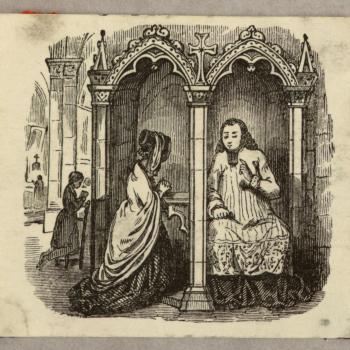 In his concise, elegant book, Jesus and the Jewish Roots of the Eucharist: Unlocking the Secrets of the Last Supper, Brant Pitre, a professor of sacred scripture at the Notre Dame seminary at New Orleans, attempts the scholarly equivalent of patting his head while rubbing his stomach and juggling chainsaws. That is, he makes a case for the Real Presence in the Eucharist for an ecumenical readership. And he does it—get this—by citing rabbinic literature.
In his concise, elegant book, Jesus and the Jewish Roots of the Eucharist: Unlocking the Secrets of the Last Supper, Brant Pitre, a professor of sacred scripture at the Notre Dame seminary at New Orleans, attempts the scholarly equivalent of patting his head while rubbing his stomach and juggling chainsaws. That is, he makes a case for the Real Presence in the Eucharist for an ecumenical readership. And he does it—get this—by citing rabbinic literature.
For too long, Pitre argues, sources like the Mishnah, the Babylonian Talmud and the Targums, among others, have been left off Christian reading lists. Mistake, says Pitre. Though compiled, in many cases, after Jesus' time, Rabbinic material constitutes a warehouse of information on the traditions that formed the worldview of Jesus' followers, as well as their adversaries. As he puts it, they "demonstrate remarkable power to explain passages in the New Testament that reflect Jewish practices and beliefs."
Those who brave rabbinic waters, Pitre assures us, quickly discover that the first-century Jewish headspace is not as we've gotten used to imagining. Rather than a strictly "military Messiah," most Jews of the first century understood the prophets to have promised them a re-run of Exodus: a new Moses, who would seal a new covenant, build a new temple and lead them to a new promised land. The new covenant, like the original, was to culminate in a banquet where "the righteous would see God and feast on the divine presence." The "new exodus" script was so widely accepted, according to first-century historian Flavius Josephus, that crackpots and con men dined out on promises to part rivers and knock down walls.
Jesus' earthly actions, according to Pitre, demonstrate that He took His cues from this plan. Luke's account of the Transfiguration refers to His imminent "exodus" from Jerusalem, meaning both His departure from this life, and to the commencement of God's new covenant with Israel. This exodus is preceded by a new Passover, the Last Supper. Like traditional Jewish paschal celebrations, it reaches its climax when Jesus pours out the blood of the paschal lamb, which He identifies as His own. The Last Supper, in turn, is preceded by Jesus' speech in the synagogue at Capernaum, where He refers to his flesh in other Mosaic terms—as the manna from heaven whose return Jews expected to signal the Messiah's arrival.
And so it goes. Pitre tallies up the clues identifying Jesus with Moses, lamb, manna, temple and Bread of the Presence—those twelve loaves that resided in the Tabernacle, and which the priests displayed during festivals as an earthly sign of God's love. Those who heard Jesus declare that eating His flesh was the key to eternal life might have reacted in horror. But in fact, Pitre argues, when it came to fulfilling expectations of a new exodus and a new covenant, making Himself edible was the most logical thing Jesus could have done.
Pitre, like Scott Hahn, who wrote the book's foreword, is used to addressing popular audiences, and it shows. Like the best lecturers, he graces his readers with routine status checks, reviewing points argued earlier and making explicit their connection to new material. Without assuming any knowledge on readers' parts—a wise move in my case—he engages their critical faculties. In short, Pitre offers airplane reading with true intellectual heft. If Dan Brown could do that, he'd be dangerous.
It's true, Pitre lacks Hahn's passion for punning—mourn or rejoice, according to your tastes.
Now, for me, Biblical exegesis has always looked like a terrifying maze. Like the Catholic of stereotype, I generally leave it to wonks and Protestants. But Pitre's book, simply by being so accessible, forced me to consider questions I'd thought unanswerable. If first-century Jews weren't expecting a military Messiah, but someone very much like Jesus, why did intellectuals receive Him so coolly? Ought they not have connected the dots? Did their human qualities—perhaps their attachment to the status quo—prevent their doing so? Did Jesus' claim of divinity kill the deal by itself? Or could Jesus have confounded expectations in some way Pitre hasn't considered?
Read the complete first chapter, here
Additional review and discussion of the book.





